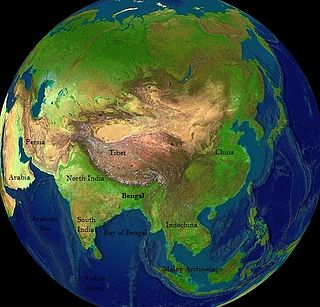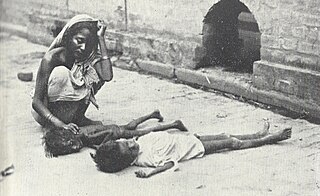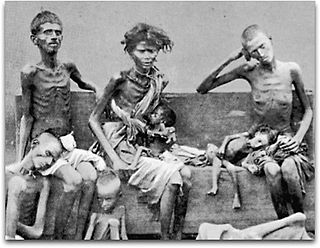
Bangladesh, officially the People's Republic of Bangladesh, is a country in South Asia. It is the eighth-most-populous country in the world, with a population of around 169 million people in an area of 148,460 square kilometres (57,320 sq mi). Bangladesh is among the most densely populated countries in the world, and shares land borders with India to the west, north, and east, and Myanmar to the southeast; to the south it has a coastline along the Bay of Bengal. It is narrowly separated from Bhutan and Nepal by the Siliguri Corridor; and from China by the Indian state of Sikkim in the north. Dhaka, the capital and largest city, is the nation's political, financial and cultural centre. Chittagong, the second-largest city, is the busiest port on the Bay of Bengal. The official language is Bengali, one of the easternmost branches of the Indo-European language family.

Bengal is a historical geographical, ethnolinguistic and cultural term referring to the eastern part of the Indian subcontinent at the apex of the Bay of Bengal. The region of Bengal proper is divided between modern-day Bangladesh and the Indian state of West Bengal. The administrative jurisdiction of Bengal historically extended beyond the territory of Bengal proper. Bengal ceased to be a single unit after the partition of India in 1947.

Sheikh Mujibur Rahman, often shortened as Sheikh Mujib or Mujib, also widely known as Bangabandhu, was the founder of Bangladesh. He first served as the titular president of the Provisional Government of Bangladesh between April 1971 and January 1972. He then served as Prime Minister of Bangladesh from the Awami League between January 1972 and January 1975. He finally served as President again during BAKSAL from January 1975 till his assassination in August 1975. In 2011, the 15th constitutional amendment in Bangladesh referred to Sheikh Mujib as the Father of the Nation who declared independence; these references were enshrined in the fifth, sixth, and seventh schedules of the constitution.

Huseyn Shaheed Suhrawardy was a Pakistani barrister and politician. He served as the Prime Minister of Pakistan from 1956 to 1957 and before that as the Prime Minister of Bengal from 1946 to 1947 in British India. In Pakistan, Suhrawardy is revered as one of the country's founding statesmen. In Bangladesh, Suhrawardy is remembered as the mentor of Bangladesh's founding leader Sheikh Mujibur Rahman. In India, he is seen as a controversial figure; some hold him responsible for the 1946 Calcutta Killings, for which he is often referred as the "Butcher of Bengal” in West Bengal. In India he is also remembered for his performance as the Minister for Civil Supply during the Bengal famine of 1943.
Events in the year 1943 in India.

The Ganges Delta is a river delta in the Bengal region of South Asia, consisting of Bangladesh and the Indian state of West Bengal. It is the world's largest river delta and it empties into the Bay of Bengal with the combined waters of several river systems, mainly those of the Brahmaputra river and the Ganges river. It is also one of the most fertile regions in the world, thus earning the nickname the Green Delta. The delta stretches from the Hooghly River east as far as the Meghna River.

The Bengal famine of 1943 was a famine in the Bengal province of British India during World War II. An estimated 800,000 to 3.8 million Bengalis perished, out of a population of 60.3 million, from starvation, malaria and other diseases aggravated by malnutrition, population displacement, unsanitary conditions and lack of health care due to a combination of factors, including government policies, war-time disruption of food distribution, and high cyclones and floods. Millions were impoverished as the crisis overwhelmed large segments of the economy and catastrophically disrupted the social fabric. Eventually, families disintegrated; men sold their small farms and left home to look for work or to join the British Indian Army, and women and children became homeless migrants, often travelling to Calcutta or other large cities in search of organised relief. Some scholars characterise the famine as anthropogenic (man-made), asserting that wartime colonial policies exacerbated the crisis. Others argue that the famine was the result of natural causes.
Great Famine may refer to:

Zainul Abedin also known as Shilpacharya was a prominent Bangladeshi painter. He became well known in 1944 through his series of paintings depicting some of the great famines in Bengal during its British colonial period. After the Partition of Indian subcontinent he moved to East Pakistan. In 1948, he helped to establish the Institute of Arts and Crafts at the University of Dhaka. The Indian Express has described him as a legendary Bangladeshi painter and activist. Like many of his contemporaries, his paintings on the Bengal famine of 1943 are viewed as his most characteristic works. His homeland honored him with given the title "Shilpacharya" "Great teacher of the arts" for his artistic and visionary attributes. He was the pioneer of the modern art movement that took place in Bangladesh and was rightly considered by Syed Manzoorul Islam as the founding father of Bangladeshi modern arts, soon after Bangladesh earned the status of an independent republic.

Famine had been a recurrent feature of life in the South Asian subcontinent countries of India and Bangladesh, most notoriously under British rule. Famines in India resulted in more than 30 million deaths over the course of the 18th, 19th, and early 20th centuries. Famines in British India were severe enough to have a substantial impact on the long-term population growth of the country in the 19th and early 20th centuries.

The Bengal Famine of 1770 was a famine that struck Bengal and Bihar between 1769 and 1770 and affected some 30 million people. It occurred during a period of dual governance in Bengal. This existed after the East India Company had been granted the diwani, or the right to collect revenue in Bengal by the Mughal emperor in Delhi, but before it had wrested the nizamat, or control of civil administration, which continued to lie with the Mughal governor, the Nawab of Bengal Nazm ud Daula (1765-72).
The Bangladesh famine of 1974 began in March 1974 and ended in about December of the same year. The famine is considered one of the worst in the 20th century; it was characterised by massive flooding along the Brahmaputra River as well as high mortality.

Bengalis, also rendered as Bangalee or the Bengali people, are an Indo-Aryan ethnolinguistic group originating from and culturally affiliated with the Bengal region of South Asia. The current population is divided between the independent country Bangladesh and the Indian states of West Bengal and Tripura, Barak Valley, Andaman and Nicobar Islands, Jharkhand and part of Meghalaya and Manipur. Most of them speak Bengali, a language from the Indo-Aryan language family.

The first president of Bangladesh, Sheikh Mujibur Rahman, and most of his family were killed during the early hours of 15 August 1975 by a group of young Bangladesh Army personnel who invaded his Dhanmondi 32 residence as part of a coup d'état. Minister of Commerce Khondaker Mostaq Ahmad immediately took control of the government and proclaimed himself president. The assassination marked the first direct military intervention in Bangladesh's civilian administration-centric politics. 15 August is National Mourning Day, an official national holiday in Bangladesh.

Nobanno is a Bengali harvest celebration usually celebrated with food and dance and music in Bangladesh and in the Indian states of West Bengal, Tripura and Assam's Barak Valley. It is a festival of food; many local preparations of Bengali cuisine like pitha are cooked.

Sayyid Najabat Ali Khan Bahadur, born Mir Phulwari, better known as Saif ud-Daulah succeeded his younger brother Nawab Nazim Najimuddin Ali Khan, after his death in 1766, as the Nawab Nazim of Bengal and Bihar.

The Bengal Subah, also referred to as Mughal Bengal, was the largest subdivision of the Mughal Empire encompassing much of the Bengal region, which includes modern Bangladesh and the Indian state of West Bengal, Indian state of Bihar, Jharkhand, Odisha between the 16th and 18th centuries. The state was established following the dissolution of the Bengal Sultanate, a major trading nation in the world, when the region was absorbed into the Mughal Empire. Bengal was the wealthiest region in the Indian subcontinent, due to their thriving merchants, Seth's, Bankers and traders and its proto-industrial economy showed signs of driving an Industrial revolution.

The Sealdah–Ranaghat–Gede line connects the Sealdah Main and North terminus of Kolkata with Ranaghat and Gede of Nadia district of West Bengal, India. Once a part of the old Calcutta–Siliguri main line, today it is a busy suburban section of the Kolkata Suburban Railway's Sealdah North section connecting the North 24 Parganas and Nadia districts with Kolkata. It is under the jurisdiction of the Sealdah railway division of the Eastern Railway zone of the Indian Railways.

Muslin, a cotton fabric of plain weave, was historically hand woven in the areas of Dhaka and Sonargaon in Bangladesh and exported for many centuries. The region forms the eastern part of the historic region of Bengal.














